‘Ger van Elk was here’
In the National Gallery in London there is a full-length double portrait of the Italian merchant Giovanni Arnolfini and his bride Giovanna Cenani, painted in 1434 by the Flemish artist Jan van Eyck. She has placed her hand in his; as they stand before the nuptial bed the two of them are entering into a pact. Between them hangs a convex mirror reflecting these two figures from behind and also two others facing the mirror, one of them probably the artist, for above the mirror is written ‘Johannes de eyck fuit hic’ (Jan van Eyck was here). These words not only give the panel a signature but make it into a document. This must have been the first time that an artist portrayed himself in a designated function.
The Dutch artist Ger van Elk (1941-) has frequently assigned himself a particular role in his work. In various interviews he has always explained this by saying that he himself was the cheapest model because he was always available. In Amsterdam he attended what is now known as the Gerrit Rietveld Academy from 1959 to 1961, when he left for Los Angeles. There he continued his training until 1963, but concentrated on studying history of art at the Immaculate Heart College. After travelling extensively through South and Central America he returned to the Netherlands in 1967. He still divides his time between the Netherlands and the New World.
Ger van Elk was twenty-two years old when the musician and designer George Maciunas explained in a manifesto the choice of the name ‘fluxus’ for his international and interdisciplinary movement. Fluxus was against expensive works of art, marketable art and commercial galleries. Fluxus rejected the attention given to individual artists, and as an antidote to this organised group activities of an unconventional nature. Cologne, Paris, London and Amsterdam were some of its centres in Europe. Among the participants were Wolf Vostell, Nam June Paik, Christo, Cage and Wim T. Schippers. It seemed as if the spirit of Dadaism had been reborn. Schippers and Ger van Elk worked together in 1962. Van Elk did not take part directly in the international fluxus movement but he felt drawn towards its informal collaborative way of thinking and acting. And some art critics rightly saw a
[p. 216]
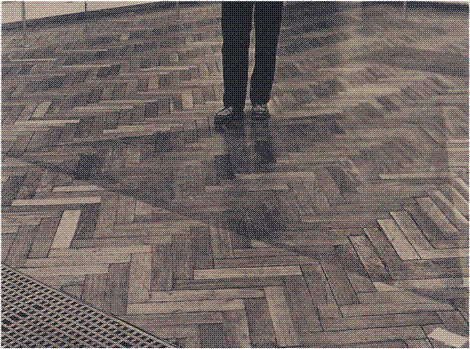
Ger van Elk, Well Polished Floor Piece. 1969, Photograph, 150 × 150 cm. Museum Boymans-van Beuningen, Rotterdam.
similarity between Marcel Duchamp, forerunner of the Dadaists, and Ger van Elk in their way of thinking and working; for both of them an unconventional theme was more important than the form.
An early example is the cactus that Ger van Elk lathered with shaving soap in 1969 and subsequently shaved clean with a safety razor. Two photos of The Well Shaven Cactus are evidence of this act. The first photo shows the lathered-up cactus with shaving tackle; in the second the tackle has been moved and the cactus stripped of its stubble. The photos do not make a documentary record of the action as a film or a series of photos would do, but by choosing the two important phases, before and after shaving, the emphasis is placed on the absurdist idea. The act itself, which for fluxus is always the main aim, remains, as does the performer, out of sight.
Yet this is not the case in the Well Polished Floor Piece dating from the same year. The photo that celebrates the floor-polishing shows a pair of male legs which tell us Ger van Elk was active here. They stand there like initials, a sign that the work has been completed and can be released, like a signature on a piece of sculpture or a painting. Unlike the group activities of fluxus, they attest to the individual artist's involvement in his work.
In Ger van Elk's oeuvre the photo occupies a prominent, even central position. Originally the photo recorded a single act as in The Well Shaven Cactus, but eventually the medium was to lose its documentary character. Since a photo - however much it may be manipulated - records whatever is there to be observed, it can be said that, as Ger van Elk himself has said, his art aims at a realistic depiction of non-realistic situations.
The photos of The Well Shaven Cactus record a Dadaist-absurdist event, the photo of the Well Polished Floor Piece a domestic activity: the polishing of a parquet floor. In his later work Ger van Elk has often made use of the triangle as a composition form: always seeking to stimulate the viewer's visual faculty, he has developed a preference for unusual frames.
[p. 217]
‘What I am after is a realistic depiction of non-realistic situations’
When Ger van Elk was in Los Angeles in 1971 he was confronted by the aftermath of an earthquake. Under a chunk of asphalt from a road that had been torn open he found a cigarette packet with some cigarettes still in it. This gave him the idea for the two photos of The Discovery of the Sardines. He replaced the cigarettes by sardines because he is crazy about sardines. Emerging from the cracks in the road, the small silver fish at first seem to be emerging from a dark underworld of human society, making a fascinating surrealistic image. In contrast with this enigma from another world, a fast car is speeding by whose chauffeur apparently has no eye for miracles.
The subtitle Placerita Canyon, Newhall, California indicates that the artist has not yet relinquished the documentary character of The Discovery of the Sardines; he is eager to convince us of the veracity of his vision.
So in addition to an affinity to Dadaism Ger van Elk's work has a bond with surrealism, the movement that was to succeed Dada historically. Van Elk's surrealism, however, has no Freudian overtones, nor is it in any way didactic, probably because wonder is its source of inspiration. What Van Elk offers us is not figments of the imagination but, like Picasso, finds and inventions.
In the series The Missing Persons (1976) Ger van Elk likewise presents us with a realistic depiction of a seemingly realistic situation. For example, in one photo from the series five statesmen are standing in a row for the official photographic record of their historic meeting, with an uncomfortable gap between two of them. In another three people are sitting together in overstuffed armchairs, all eyes directed towards an absent party. The photos allude to the way in which under dictatorial regimes figures are removed from official photos when people who have fallen from favour have to be expunged from the nation's memory. Ger van Elk constantly accentuates the
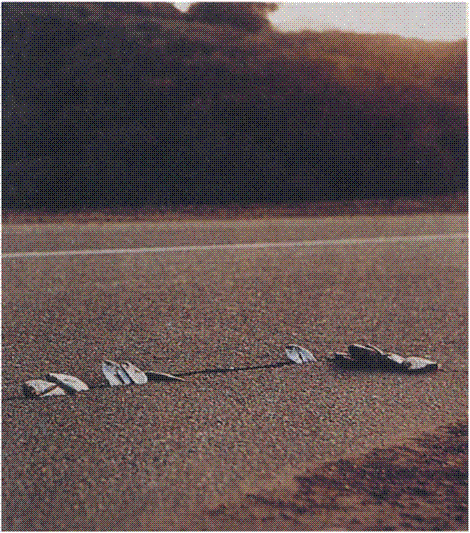

Ger van Elk, The Discovery of the Sardines. Placerita Canyon, Newhall, California. 1971. Two colour photographs (separately framed; 4th ed.), (2x) 65.5 × 55 cm. Collection Becht, Naarden.
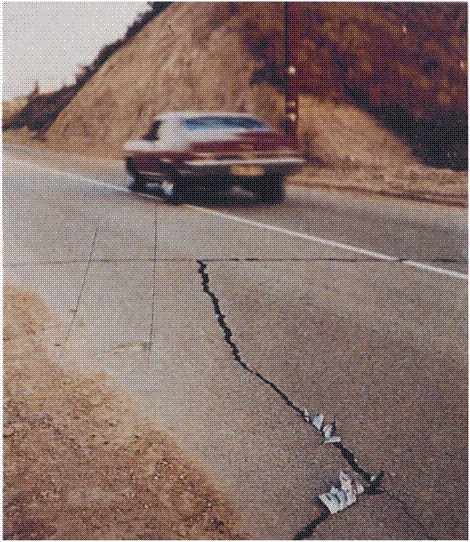
[p. 218]
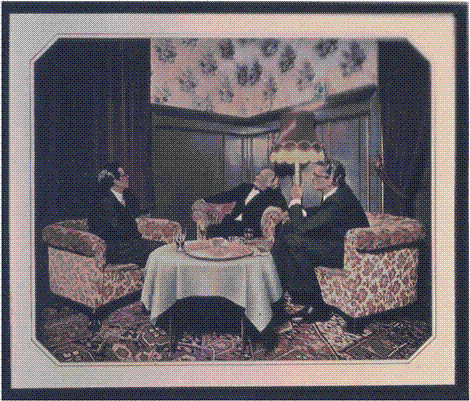
Ger van Elk, The Missing Persons. Conversation Piece. 1976. Coloured photograph, 106 × 124 cm. Collection Nigel P. Greenwood, London.
artificiality of this kind of situation through, for instance, the poses the figures strike, their shiny pomaded hair or the garish nature of their surroundings. The photos are coloured in and sometimes rephotographed to bring home to the viewer how he has begun to take artificiality for granted.
In the series The Adieu (1974) the realism in a non-realistic situation is more complex. The artificiality is already anticipated in the title derived from two languages. A painting may be seen on an easel; on the painting is a path bordered by wintry-looking trees, a cliché for the romantic attitude to nature. The path leads the eye to the horizon as in Hobbema's famous Avenue in Middelharnis (1689), a painting that has been inspiring both professional and Sunday painters of the realistic-naturalistic type for over three hundred years now. On the path in The Adieu Ger van Elk is standing waving goodbye to the viewer, as if about to turn around, walk down the path and vanish. Relatively speaking, he is not much larger than Jan van Eyck in the National Gallery portrait but here he is the only figure doing anything, in fact he is the only figure in the ‘painting’ on the easel, which is foreshortened. If the canvas were to be turned further away from us the figure of Van Elk would also become invisible. The foreshortening emphasises the artist's gesture of farewell which gives the work its title. The ‘canvas’ on the easel also seems to be about to disappear through the heavy blue curtains that ‘hang’ behind it. The clichéd counterfeit of nature, not even painted in oils but a coloured-in photograph, is framed by luxurious textile. The one artificiality reinforces the other. Is art going to disappear together with Van Elk? In any event, with its incongruous frame The Adieuprovides an ironic and whimsical commentary on the artificiality of traditional painting.
[p. 219]
‘The only thing one can do is rebel’
In a 1977 interview with the German art historian Antje von Graevenitz Ger van Elk said that he wanted to reconsider his point of view continually. To this he added: ‘The only thing one can do is rebel.’ These remarks clearly show that Ger van Elk has no intention of pursuing the same artistic course all the time. As his art is chiefly defined by its content, this, if it is to be innovative, requires shifts of view point. In the same spirit, the Flemish avantgarde poet and theoretician Paul van Ostaijen (1896-1928) wrote: ‘I get up in the morning with the problem: what can I do now that hasn't been done before.’ The problem of artistic renewal, crucial to every artist, is even more urgent for Ger van Elk because, preoccupied with the subject matter as he is, he is averse to an unchanging, recognisable style. His art, like his theoretics, is essentially dynamic.
In 1980 a large work, Triangle Balance Pull, came into being. Two figures appear to be pulling so hard on a rope that, with the soles of their feet set against each other, they and the rope form a horizontal diagonal. It is a trial of strength between two adult men, in which perspectival lengthening (of the legs) and foreshortening (of the trunk) give the viewer the sensation of witnessing a supreme effort. A formal balance is struck not only by the triangle, the various shades of red for the figure on the left also offset the violet-blue of the figure on the right. It is Ger van Elk who with his full length pits himself against Ger van Elk and in this way holds himself in balance.
By rejecting the support of a consistent style Ger van Elk frequently
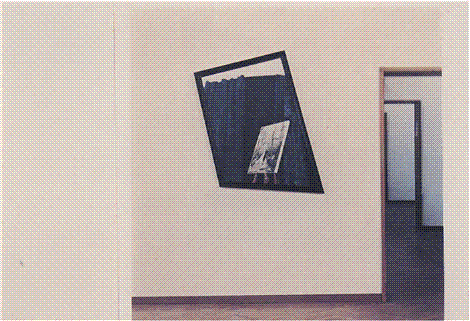

Ger van Elk, The Adieu. 1974. Gouache and ink on colour photograph (in irregular quadrilateral frame), 132 × 84 cm. Stedelijk Museum, Amsterdam.
[p. 220]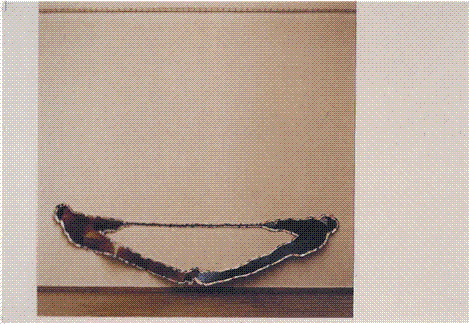
Ger van Elk, Triangle Balance Pull. 1980. Colour photographs and acrylic paint on canvas, 110 × 490 cm. Stedelijk Museum, Amsterdam.
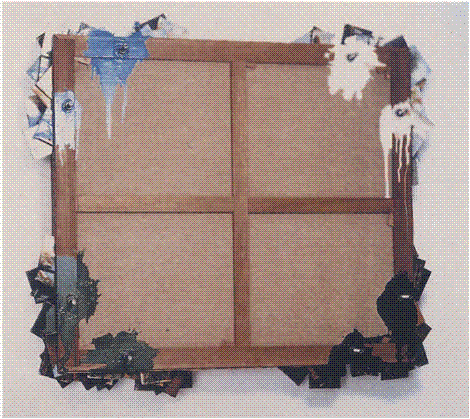
Ger van Elk, Paysage Saignant (Pressure Sandwich). 1991. Oil on canvas / steel / paintings, 226 × 254 × 50 cm. Collection Liliane and Michel Durant-Dessert, Paris.
arrives at crossroads where he has to decide his direction without the help of a map. This is why he makes a figure of himself, or sometimes even two figures; Van Elk tussling with Van Elk in Triangle Balance Pull or Van Elk debating with Van Elk in The Western Stylemasters (1987). Furthermore, the title of the second work is in deliberate opposition to his desire not to be a stylemaster.
[p. 221]
In 1971 in The Return of Pierre Bonnard, 1917-1971 Ger van Elk displayed the back of a painting with stickers on it showing where and when it had been exhibited. And in 1975 in The Last Adieu, a work from the series The Adieu, he showed three paintings visible from the back only. If the artist was portrayed, the method of presentation made him invisible. In 1991 he took up the theme of the back that becomes the front once more by giving it the form of a sandwich. Since then he has employed the concept of the sandwich in a large number of variations.
The work created in 1991 has the half English, half French title ofPaysage Saignant (Pressure Sandwich). As in The Return of Pierre Bonnard, 1917-1971, it is the back of a painting that is shown to us. Four canvasses have been screwed together, with a number of small landscape paintings wedged between them. Parts of these small paintings protrude out of the sandwich; the screws, one must assume, go right through some of them. The large splotches of paint around the screws create the impression, reinforced by the title, that the paint has been squeezed out of the small wedged-in paintings.
This drastic representation, which almost hurts the viewer physically, takes sides in the clash between serious artists and the numerous unoriginal producers of painted landscapes. The second-rate work is a wan reflection of the great movements and styles; it is the work of the imitators of the masters. There is no question of peaceful co-existence: great art crushes the rest, puts thumbscrews on it, reduces it to the garbage of art history. This is art's blood-stained battlefield.
In the spring of 1993 a large exhibition of new work by Ger van Elk was held in the Boymans-van Beuningen Museum in Rotterdam. The sandwich concept was so central to the exhibition that it was entitled Sandwiches, Pressing, Pushing, and Pulling. The tone was set by three-dimensional objects, varying in size from two to five metres. As early as 1968 Ger van Elk had made three-dimensional objects. In 1977 he told Antje von Graevenitz: ‘I chose film in order to add moving parts to sculpture’ (my italics).
At the Boymans-van Beuningen exhibition photographed and painted men's heads, already familiar to the viewer, were subjected to physical torture
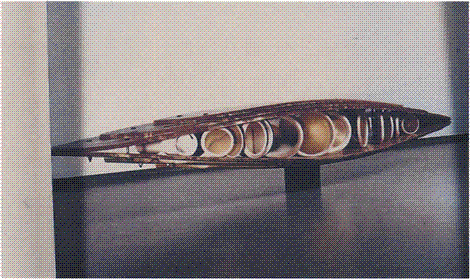

Ger van Elk, Bitch. 1992. Gloss paint and varnish on wood / framed photographs under glass, 74 × 452 × 63 cm (Photo: Museum Boymans-van Beuningen, Rotterdam, 1993 exhibition).
[p. 222]
in various objects. In Bitch (1992) it is the turn of the female sex to be tormented. Photos of parts of female breasts and buttocks which, encased in circular pink frames, form an erotic ensemble, join forces to resist the pressure of the broad planks they are wedged between. The danger of being crushed makes the tension even greater than in Triangle Balance Pull. The ‘jaws’ that threaten to snap shut can, as the title suggests, also be seen as a vagina.
Exercise of Love, Hope and Faith from the same year is equally misogynistic. Stabbing red-, white- and black-lacquered women's fingernails protrude between the layers of a circular threedecker sandwich. On the top small pink noses poke through cracks in five places, suggesting that the rest of the bodies have been crushed. The size of the noses indicates that these men were no match for the super vamp. As in Bitch,deeply rooted fears are expressed here.
In his most recent work Ger van Elk depicts realistic situations surrealistically. Here he introduces a new theme: the battle between the sexes, its aggressivity and the traumas which result from it. While his early work already showed a remarkable amount of physical activity, violence has come to the fore since 1991.
In these latest works Ger van Elk is more present than ever. It can no longer be maintained, as he himself has done in various interviews, that he presents himself because he is the cheapest model. His own existence is now what is at stake. Presenting himself in his work has come to mean an almost physical resistance to threatening forces. With this, the rebellion which has been the guiding principle of his work down the years, has taken a dramatic turn.
jose boyens
Translated by Elizabeth Mollison.
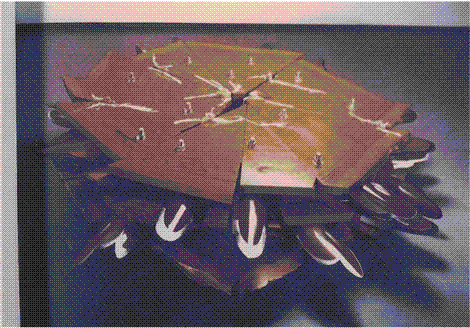
Ger van Elk, Exercise of Love, Hope and Faith. 1992. Gloss paint and varnish on wood / ceramic / steel / photographs, 71 × 263 cm (Photo: Museum Boymans-van Beuningen, Rotterdam, 1993 exhibition).
Ger van Elk, Nederlands boegbeeld conceptuele kunst, overleden (73)

Ger van Elk in 2010 met op de achtergrond twee foto's die van hem zijn gemaakt in 1993 in museum Boijmans van Beuningen in Rotterdam. Foto NRC / Vincent Mentzel
CULTUUR

De internationaal vermaarde beeldend kunstenaar Ger van Elk is overleden. Dat melden twee galeries die hem vertegenwoordigen. Van Elk was onder meer bekend van zijn conceptuele sculpturen, installaties en beschilderde foto’s. Hij is 73 jaar oud geworden.
BorzoArt Borzo GalleryIn Memoriam GER VAN ELK. Overleden op zondag 17 augustus. Groot kunstenaar en lieve vriend.16 uur geleden
Van Elk wordt samen met Jan Dibbets en Marinus Boezem gezien als de belangrijkste vertegenwoordiger van de conceptuele kunst in Nederland. Hij werkte met allerlei materialen, waaronder touw, canvas en hout. Zijn kunst is tentoongesteld in het Stedelijk Museum in Amsterdam, Museum Boijmans Van Beuningen in Rotterdam, het Museum of Contemporary Art in Chicago en The Museum of Modern Art in New York.
EEN BESCHEIDEN MEESTERWERK
“Hij was één van de weinige Nederlandse kunstenaars die internationaal is doorgebroken”, zegt redacteur beeldende kunst Sandra Smallenburg. Hij was vertegenwoordigd in internationaal toonaangevende tentoonstellingen, zoals ‘Op losse schroeven/Situaties en cryptostructuren’ in het Stedelijk Museum, ‘When Attitudes Becomes Form’ in de Kunsthalle in Bern, beide in 1969, en ‘Sonsbeek buiten de perken’ in 1971. Smallenburg:
“Vorig jaar was bij de Fondazione Prada in Venetië, gelijktijdig met de Biënnale, een remake te zien van ‘When Attitudes Becomes Form’. Daar zat Van Elk weer bij, samen met Walter De Maria, Robert Smithson en Jan Dibbets.”
Zijn meesterwerk was La Pièce, zegt Smallenburg, een klein, witgeschilderd blokje hout op een roodfluwelen kussentje.
“Hij schilderde het midden op de oceaan wit, omdat de lucht zo zuiver en stofvrij mogelijk moest zijn. Hij maakte het op kruising van twee oceaanwinden. Het was een klein werkje, dat hij later exposeerde op een roodfluwelen kussen onder een glazen stolp, alsof het een diamant was. Het was een reactie op de spektakelkunst van de Amerikanen, zoals Robert Smithson, die in de jaren zeventig zo megalomaan mogelijk werkten door bijvoorbeeld in de natuur kilometers lange kunstwerken te bouwen.”

Foto van Sportive Time Study van Van Elk in het Kröller-Müller. Foto ANP/Ed Oudenaarden
GEEN FOTOGRAAF, GEEN SCHILDER. WEL NIEUWSGIERIG
Van Elk was in zijn kunst veel bezig met de kunst zelf. “Ik ben geen fotograaf en een schilder ben ik ook niet”, zei hij in 2012 in een interview met NRC Handelsblad.
“Ik ben geen fotograaf. Een schilder ben ik ook niet, zelfs niet als ik schilder. Ik onderzoek wel vaak de tradities van de schilderkunst. Ironisch zou ik mijn werk niet willen noemen. Ik ben eerder een romanticus. Als ik iets ben, is het nieuwsgierig. Voor sommige mensen lijkt het alsof ik van de hak op de tak spring, maar ik ben streng op wat ik maak.”
Van Elk over zijn meesterwerk La Pièce:
“La Pièce heb ik pas een paar jaar geleden verkocht. Christophe Cherix, conservator van het Museum of Modern Art in New York zag het bij mij op het atelier in Amsterdam en zei: ‘Hé, heb je er nog een gemaakt?’ Hij kon niet geloven dat La Pièce niet was aangekocht door een museum. Een paar weken later kreeg ik opeens bezoek van Evert van Straaten, de directeur van het Kröller-Müller. Hij vroeg wat ik ervoor wilde hebben. Twee ton, zei ik. ‘Dat gaan we organiseren’, zei hij. En dat is gelukt. Ach, mensen zien op het moment zelf bijna nooit wat goed is.”
Van Elk over zijn jeugdjaren in de VS:
“Toen ik twaalf was, was ik een lastig jongetje. Hopeloos. Op school in Nieuwendam wisten ze niet wat ze met me aan moesten. Ik moest een test doen bij het nationaal katholiek instituut voor beroepskeuze. Daar kwam uit dat ik fotograaf of binnenhuisarchitect moest worden. Mijn vader, die toen al lang in Los Angeles woonde, zei, ‘Ach jongen, kom maar naar Amerika, kom bij mij werken.’ Hij werkte in de tekenfilmindustrie, bijvoorbeeld voor The Flintstones. Ik ben inderdaad na een jaar op de Rietveld Academie naar Amerika gegaan, niet naar mijn vader, maar naar het Immaculate Heart College. Dat was een te gekke school, je kreeg les van allerlei rare types. Ik kreeg kunstgeschiedenis van nonnen, maar dan wel nonnen die in Cadillacs rondreden. John Cage gaf er ook les.”“Ik heb lang tussen Amerika en Nederland op een neer gereisd. Nu ben ik alweer tien jaar vooral hier. Amerika is heel spannend, maar ik heb ook de melancholie van Europa in me.”
Ger van Elk, kunstenaar from Deen van der Zaken on Vimeo.
Een bezoek aan een tentoonstelling in het Stedelijk Museum zou eigenlijk 75 euro moeten kosten, zei Van Elk in NRC.
“Een kaartje voor het Concertgebouw kost 75 euro en het Concertgebouw zit gewoon vol. Maar bij kunst heeft niemand er voor over wat het echt kost. Ik ben een oude VVD’er, een rechtse bal. Ik geloof ernstig in vraag en aanbod. Ik was het wel eens met de bezuinigingen op kunst. Als je er niets voor over hebt, betekent het niets, net als in de liefde.”














Geen opmerkingen:
Een reactie posten